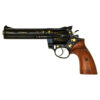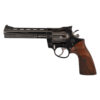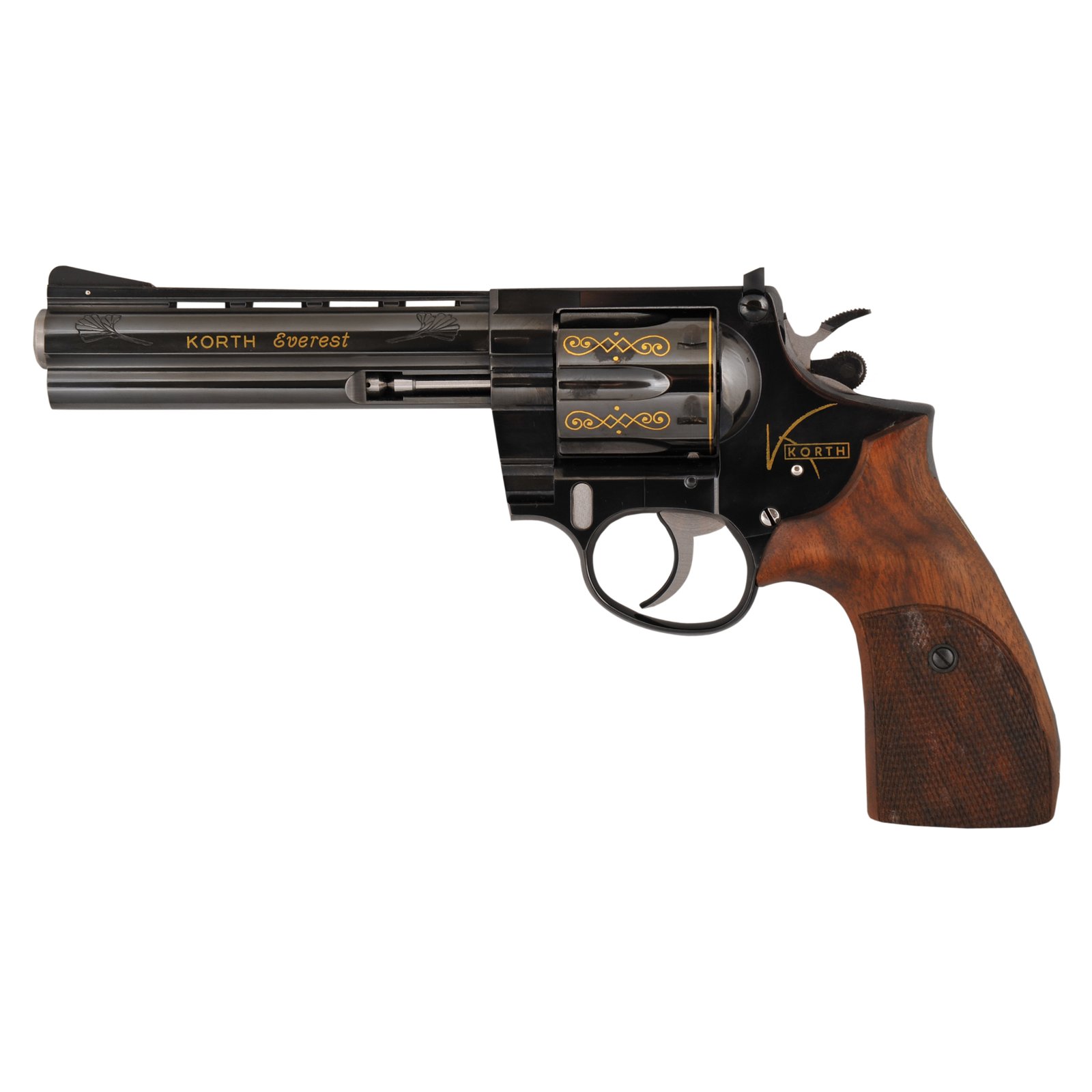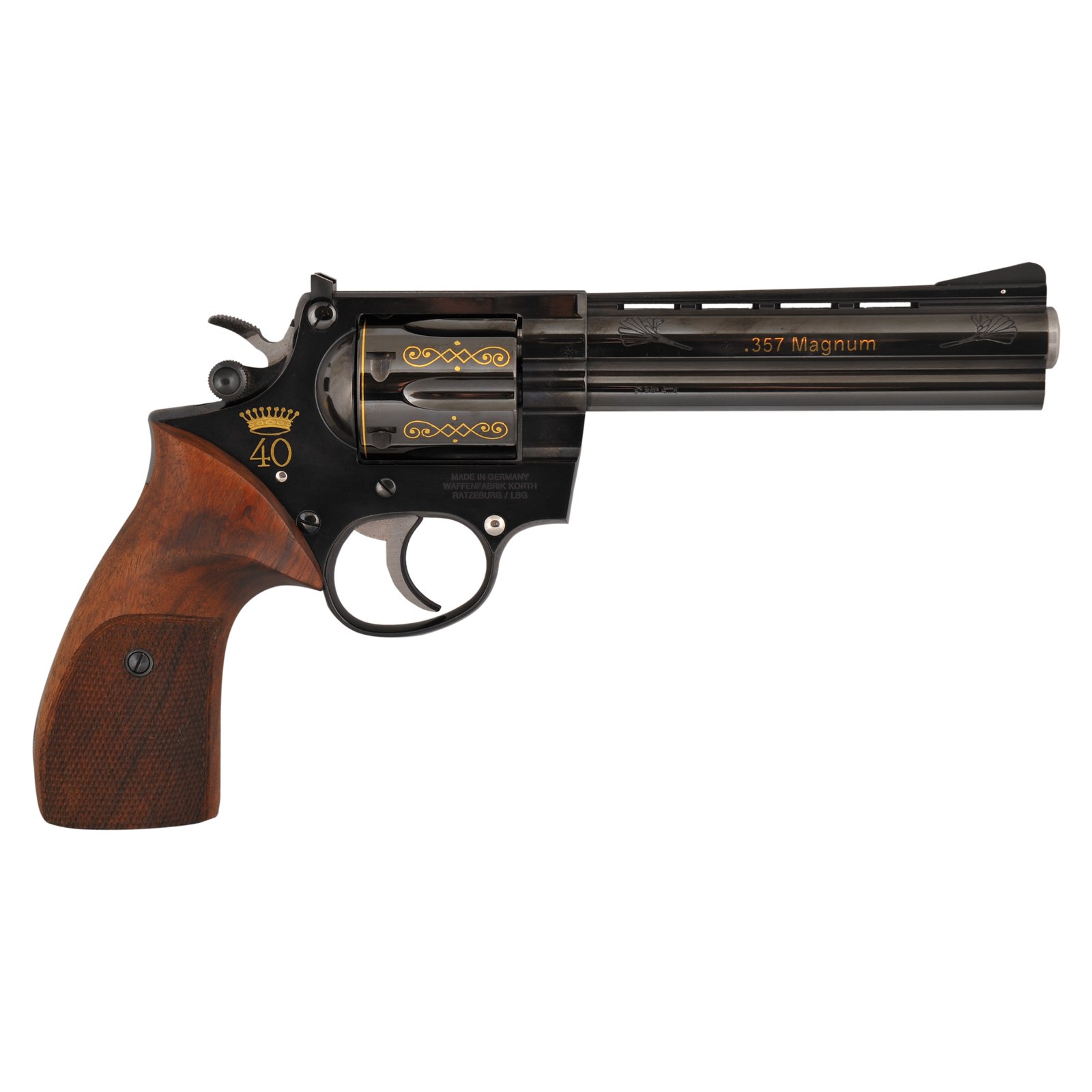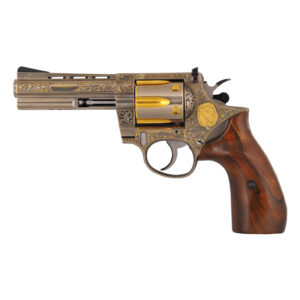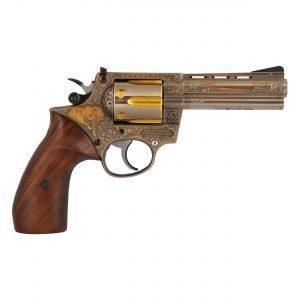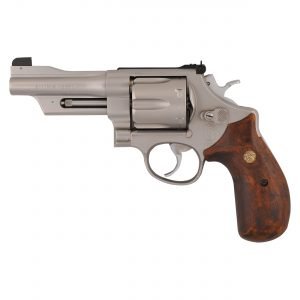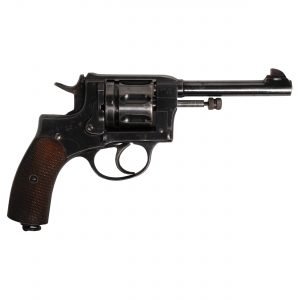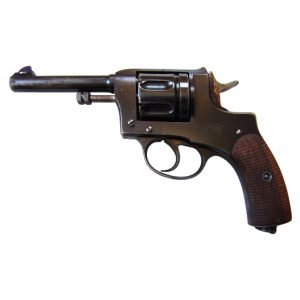Korth Revolver Everest 40 Years Special Edition .357 Magnum
€ 60.000
Korth Revolver Everest 40 Years Special Edition .357 Magnum
Model: Korth Revolver Combat Everest 40.yıl
Çapı: .357 Magnum | .38 Special
Namlu Boyu: 5.25″ (133 mm)
Kapasite: 6
Ağırlık: 40 oz | 1.100 gr (boş)
Uzunluk: 10.65″ | 270.5 mm
Üretim Yılı: 1994
Limited Edition: no 7/25 (dünyada sadece 25 adet)
Açıklama: Korth firmasının 40. kuruluş yılı anısına sınırlı sayıda dünya genelinde sadece 25 adet üretmiş olduğu çok üst düzey kalitedeki çok özel bir koleksiyon silahıdır. Silah tamamen orijinal olarak Korth fabrikasında gravürlenmiş ve üretilmiştir.
Açıklama
Korth Revolver Combat Everest 40 Years Special Edition .357 Magnum
History
Korth is a high-end firearms manufacturer based in Lollar, Hesse, Germany.
The company was founded in 1954 by Willi Korth, a railway engineer, who began his business in a basement workshop making alarm revolvers.
Willi Korth was born in Stargard / Pommern on 11 July 1913. He learned machining and toolmaking at the Deutsche Reichsbahn between 1930 and 1934. Ten years later, in the summer of 1944, he briefly worked at Mauser-Werke under contract as an independent designer of military small arms. In August of 1950 Korth moved to Ratzeburg. Next year he found a job as a manager at the Hubertus Metallwerke in Mölln. In 1952 Korth resigned to pursue his own designs. His first effort was a blank firing gas revolver. The few gas revolvers, designed and manufactured by Korth in the winter of 1954/55, are now sought after as collector’s items.
On 1 October 1955, following the expiration of the postwar ban on German manufacture of firearms, Korth founded a company in Ratzeburg under the name of Willi Korth, Waffenfabrikation. In September of 1955 Korth exercised his first manufacturing license for firearms. In 1962 he designed and manufactured his first revolver, initially chambered in .32 S&W Long, the highest caliber allowed by the terms of his license. Instead of a traditional cylinder release on the left hand side of the frame, the cylinders of these revolvers were unlatched from the frame by pulling forward the head of the ejector rod. The crane lock was released by the leftward push of a button located on the right hand side of the frame under the cylinder, whereupon the entire crane assembly complete with the cylinder would slide forward for removal from the frame.
The first series production of Korth revolvers began in 1964 with the police revolver chambered in .38 Special, serial numbered 20xxx. In 1965, Korth introduced 4″ and 6″ barreled six-shot revolvers in .22LR and .22 Magnum, and five-shot models in .357 Magnum, serial numbered in the 21xxx series. The subsequent 22xxx/23xxx series appeared in 1967, comprising a small run of 6″ revolvers in .357 Magnum and .38 Special, as well as .22LR, plus a few 4″ .357 Magnums. Its new feature was a torsion trigger spring mounted on a stud accessible on the left-hand side of the frame, and fixed with a set screw on its right hand side. This arrangement allowed an easy adjustment of the trigger pull weight between 1kg (35.274 ozs) and 2.5kg (88.185 ozs) without disassembling the revolver.
The 24xxx series, introduced in 1969, featured the definitively shaped Nill grips. The main innovation appeared in the trigger action, patented in Germany as DE 1904675 A1, and designed for a precise and tunable stacking transition in double action, achieved through the use of variously sized rollers on the trigger impinging upon the double action sear on the hammer. Thenceforth every revolver was shipped with five numbered metal wheels of different diameters that ranged from No.1 (0.283″) for the hardest stacking transition to No.5 (0.293″), for no stacking at all. Korth also added the second cylinder lock, achieved by latching the head of the axially fixed ejector rod inside a lug located under the barrel. Because the head of the ejector rod was no longer accessible for manipulation with the cylinder latched, Korth added a pivoting lever at the right side of the hammer to cause the cylinder release. The floating firing pin with its spring was retained in the frame by a transverse pin. Finally, the exposed coil mainspring gave way to the definitive sleeved telescopic design inspired by the MP38 recoil spring.
Korth revolvers feature the peculiar German implementation of the rebounding hammer, an international design that dates back at least to William Bardell and William Powell from Aston, Birmingham, with patent No. 2287 of 6 September 1866. However, Wolverhampton lockmaker John Stanton takes the credit for the type of rebounding lock found on most hammer guns encountered nowadays, as refined in three of his designs. The first, No. 49 of 8 January 1867, received only provisional protection and used an external spring to lift the hammer to half-cock. Very shortly after this Stanton secured a second patent, No. 367 of 9 February 1867, in which the return of the hammer to half-cock by the mainspring is achieved by lengthening one limb of the mainspring at the top in a bar-action lock and the bottom in a back-action lock, off which the tumbler bounces. This design was widely adopted, appearing in both new guns and as conversions to existing locks. In his third patent, No. 3774 of 30 December 1869, Stanton reverses the location of the projections on the mainspring limbs for bar-action and back-action locks, adding a characteristic curve to the end of the spring. But it was Daniel B. Wesson’s and James H. Bullard’s U.S. patent 198,228 of 18 December 1877, adapted specifically to “revolving fire-arms”, that served as the pattern for numerous subsequent designs.
Korth’s next major innovation was the production of the second, Combat revolver variant, started in 1973 with the first 15 specimens numbered in the 27xxx and continuing in the 28xxx series. The Combat configuration differed from its Sport predecessors in four ways. First off, its wedge-shaped low profile ramp front sight was matched with a rear sight of a limited adjustment range inset into the frame, while the Sport wore a high profile front sight matched with a block-shaped adjustable rear Sport sight mounted on a self-sprung tang wedged into a cutout in the rear of the barrel. Secondly, its round butt grip frame replaced the square butt on the Sport revolvers, after the fashion of the grip frames of Colt’s M1877 Thunderer and Lightning contrasting with their M1873 Single Action Army predecessors. Thirdly, the centerfire cylinder capacity was upped from five to six rounds, with the accommodation of the extra round enabled by enlarging the 37mm cylinder by 1.5mm, while maintaining the original frame size. Lastly and most significantly, Korth initiated its transition from the one-piece barrel topped with a ventilated rib and fitted with a short locking underlug, reminiscent of Dean W. King’s patented 1936 custom conversions of S&W revolvers, to a two-piece assembly comprising a tensioned barrel surrounded by a shroud topped with a ventilated rib and fitted with a full-length underlug, in an arrangement that referenced Colt’s 1955 Python externally, while replicating Karl R. Lewis’patented 1967 design originally realized by Dan Wesson. Throughout their production, Combat barrels varied in length between 77mm and 82mm, nominally designated as 3″. Meanwhile, the Sport revolvers retained their one-piece barrel fitting, with both five- and six-shot cylinders available through the 28xxx series.
In the 29xxx series introduced in 1974, Korth co-branded his revolvers with Dynamit Nobel serving as a distribution partner. Accordingly, in the series 29xxx, 30xxx, and 31xxx, there appear several versions of the company emblem. The gilded brass disc bearing the name “Dynamit-Nobel / Korth” can be seen in the series 29xxx and several revolvers of the series 30xxx. This emblem could be omitted at the request of the buyer. It was superseded by a black “Dynamit Nobel / Korth” emblem etched in the blued steel sideplate. After Korth terminated the distribution agreement with Dynamit-Nobel, the etched logo omitted the Dynamit Nobel name. All revolvers in these series were fitted with six-shot cylinders. The 30xxx series completed the transition to the two-piece barrel construction across the model range, and introduced the optional 102mm or 4″ Combat barrel configuration. Thenceforth, Korth revolvers featured three different sets of adjustable sights, the low profile Combat sights with a serrated ramp front sight and a rear sight adjustable for windage and elevation with set screws, and the click adjustable Sport and Target sights, the former requiring a screwdriver, and the latter featuring serrated wheels that can be turned by hand, without tools. Finally, the 1979 32xxx series introduced the definitive, semi-slabsided profile of the barrel shroud, and a speedloader relief cut in the recoil shield. All these features remained unchanged in the 1980 33xxx series, which for the first time added the 6″ Combat configuration.
Meanwhile, beginning in 1978, Willi Korth had refocused his design work on a new autopistol, considering the action of his revolvers fully perfected. Notwithstanding the first five prototypes produced in 1982 with features patented in Germany as DE 3111037 A1 and DE 3203991 A1, the manufacture of the first series did not start until 1989. The pistol never succeeded commercially, owing both to lack of development and the initial retail price of $6,750.00.
Willi Korth’s revolvers were benchmade by five gunsmiths at the rate averaging about 120 pieces a year. In contrast to the mass production standards, Korth revolver parts were neither cast nor milled. They were ground in the course of hard fitting from steel forgings that boasted a tensile strength of 1,700 psi. Each revolver required 70 man-hours that comprised 600 distinct operations. Their major components were surface hardened up to 60 HRC on the Rockwell hardness scale. The original production of Korth revolvers ended in 1981 with the serial number series 33xxx, adding up to a total of 7141 revolvers in calibers .38 Special, .357 Magnum, 9mm Para, .22LR, and .22 Magnum, with barrel lengths ranging from 3″ to 6″, fitted with 6-shot rimfire and both 5- and 6-shot centerfire cylinders. The three main variants were the Combat, the Sport, and the Target models, some of which were finished as engraved luxury pieces.
Korth turned over his business with all inventory, tools, and drawings to count Nikolas von Bernstorff on 30 June 1981. The company continued as Korth GmbH & Co. KG, its payroll peaking at 30 employees during the following decade. Its initial production comprised the 1982 transitional series 34xxx and 35xxx, still made under their inventor’s personal supervision, but marked “WAFFENFABRIK KORTH” rather than “WAFFENFABRIK W KORTH”. Following Korth’s resignation due to failing health in 1983, his successors produced the 36xxx, 37xxx, and 38xxx carbon steel series, mostly from the legacy parts fabricated and blanks forged by Willi Korth. Some newly manufactured major components such as barrel shrouds and cylinders were sourced from two subcontractors in Hamburg-Ahrensburg. The new owners also introduced the Fxxx matte-finished Profi series priced 25% below its luxurious siblings, added the optional 5¼” barrel configuration and .32 S&W Long chambering, and offered the luxury option of plasma finishes. Starting with the 36xxx series in 1984, the top strap of the Korth frame was made about 0.5mm thicker, adding around 9 grams to its weight. Additionally, the crane was modified with a new cylinder bushing, which eliminated the gas check relief cut of the original centerfire revolver design. These modifications strengthened the revolver and improved its cylinder support, at the cost of accelerating the erosion of the forcing cone. Lastly, the 9mm Para cylinder was milled to accommodate two extractor springs for rimless cartridges, bearing upon the flats of the extractor tube, to tension the extractor clockwise, forcing its blades into the extractor grooves of the rimless cartridge for more positive extraction. Additionally, in 1985 there appeared the short-lived Sxxx matte stainless steel series, highly sought after by collectors today.
Willi Korth died on 10 October 1992, leaving the development of his autopistol unfinished, with its production by his successors falling short of the inventor’s design goals in accuracy and reliability alike. In mid-1999 Korth GmbH underwent bankruptcy following a long production slump. Its assets were taken over in April 2000 by the Armurerie Freylinger of Luxembourg. Over the following years, five gunmakers employed by Freylinger produced the 39xxx and 40xxx series, briefly expanding into the American market by establishing a subsidiary in the United States in 2001 in a joint venture with Earl Sheehan, an independent importer of Walther firearms. In 2001, they introduced the finish option of plasma TiAlN PVD surface coating in satin and matte styles, which boasted exceptional abrasion resistance. Since 2002, Korth revolver aficionados benefited from their comprehensive historical and technical analysis by Veit Morgenroth, arguably the most detailed investigation of a sporting firearm ever to be published. Regrettably, this treatise neglected the contributions of Korth’s successors, which included the Triple Lock in the T-prefix serial number sequence, the externally tensioned mainspring, and switch-barrel configurations developed under the management of von Bernstorff.
In November 2008 the original Korth factory in Ratzeburg closed its doors. But six months later, on 22 April 2009, Andreas Weber and Martin Rothmann revived the Korth trademark in Lollar near Giessen. The new owners of Korth exhibited their 41xxx revolver series and autopistol prototypes in 2012 and 2013, both at IWA in Nürnberg and the SHOT Show in Las Vegas. In the sequel, I shall examine some representative Combat and Sport revolvers manufactured by Willi Korth and his successors.


